最新英美报刊选读—Unit 1
- 格式:ppt
- 大小:818.50 KB
- 文档页数:52
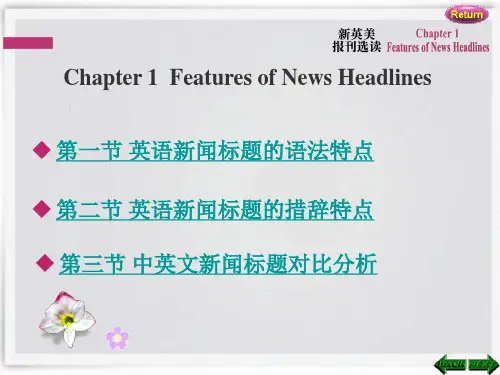
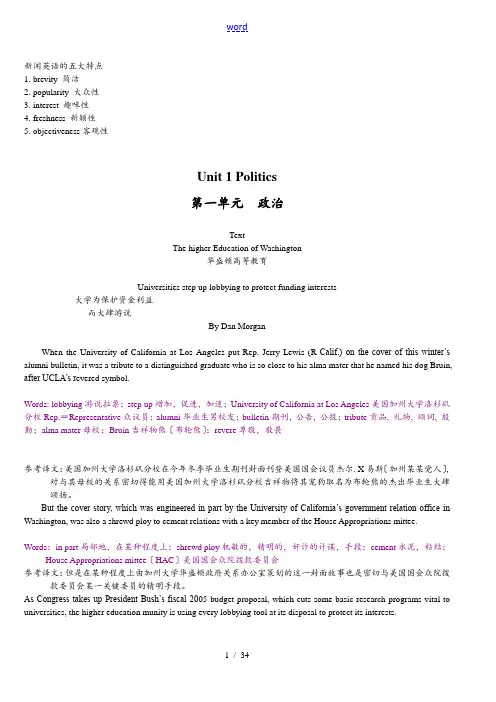
新闻英语的五大特点1. brevity 简洁2. popularity 大众性3. interest 趣味性4. freshness 新颖性5. objectiveness客观性Unit 1 Politics第一单元政治TextThe higher Education of Washington华盛顿高等教育Universities step up lobbying to protect funding interests大学为保护资金利益而大肆游说By Dan MorganWhen the University of California at Los Angeles put Rep. Jerry Lewis (R-Calif.) on the cover of this winter’s alumni bulletin, it was a tribute to a distinguished graduate who is so close to his alma mater that he named his dog Bruin, after UCLA’s r evered symbol.Words: lobbying游说拉票;step up增加,促进,加速;University of California at Los Angeles美国加州大学洛杉矶分校Rep.=Representative众议员;alumni毕业生男校友;bulletin期刊,公告, 公报;tribute贡品, 礼物, 颂词, 殷勤;alma mater母校;Bruin吉祥物熊〔布轮熊〕;revere尊敬,敬畏参考译文:美国加州大学洛杉矶分校在今年冬季毕业生期刊封面刊登美国国会议员杰尔. X易斯〔加州某某党人〕,对与其母校的关系密切得能用美国加州大学洛杉矶分校吉祥物将其宠狗取名为布轮熊的杰出毕业生大肆颂扬。
But the cover story, which was engineered in part by the University of California’s government relation office in Washington, was also a shrewd ploy to cement relations with a key member of the House Appropriations mittee.Words:in part局部地,在某种程度上;shrewd ploy机敏的,精明的,奸诈的计谋,手段;cement水泥,粘结;House Appropriations mittee〔HAC〕美国国会众院拨款委员会参考译文:但是在某种程度上由加州大学华盛顿政府关系办公室策划的这一封面故事也是密切与美国国会众院拨款委员会某一关键委员的精明手段。
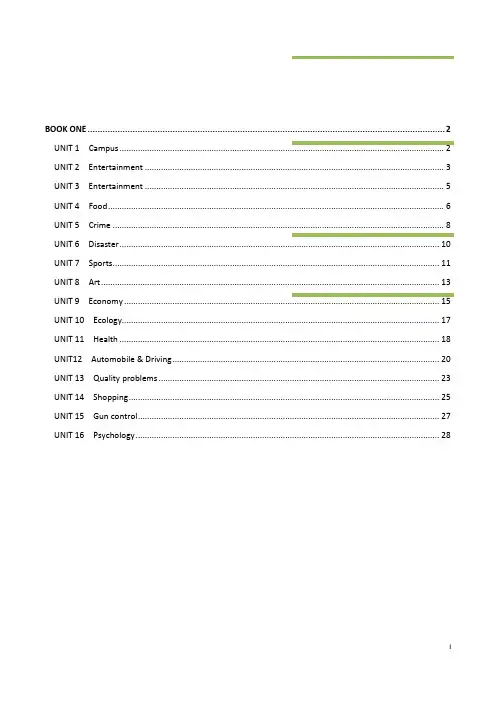
BOOK ONE (2)UNIT 1 Campus (2)UNIT 2 Entertainment (3)UNIT 3 Entertainment (5)UNIT 4 Food (6)UNIT 5 Crime (8)UNIT 6 Disaster (10)UNIT 7 Sports (11)UNIT 8 Art (13)UNIT 9 Economy (15)UNIT 10 Ecology (17)UNIT 11 Health (18)UNIT12 Automobile & Driving (20)UNIT 13 Quality problems (23)UNIT 14 Shopping (25)UNIT 15 Gun control (27)UNIT 16 Psychology (28)BOOK ONEUNIT 1 CampusI.Vocabulary Builder1.Definition1)chaotic: extremely disorganized; badly organized; be in mess2)primary: main; most important; key; major; chief; prime; principal3)seduce: attract; tempt4)highlight: the most important, interesting, or enjoyable part of something such as a holiday,performance, or sports competition5)reluctant: unwilling6)compelling: very interesting or exciting, so that you have to pay attention7)reveal: show; indicate8)mainstream: accepted by or involving most people in a society; normal; ordinary9)critical: important; crucial10)evolution: a long, gradual process during which something develops and changes, usuallybecoming more advanced; a gradual change and development2. Terms translation1) a bipartisan consensus2)high school diploma3)drop-out rate4)college wage premium5)the K-12 system6)more academically rigorous7)well-rounded citizens8)certification tests9)career and technical education3. Blank filling1) persevered 2) persisted 3) insisted 4) insisted 5) persevere6) agony 7) adversity 8) torment 9) plight 10) assure/reassure11) insure/ensure 12) insure 13) insure/ensure 14) assured/reassuredII.Translation1.选择圣路易斯的华盛顿大学是个不错的决定,但真正让我享受到理想大学生活的,(不是大学本身)是我到了大学后作的一些决定。

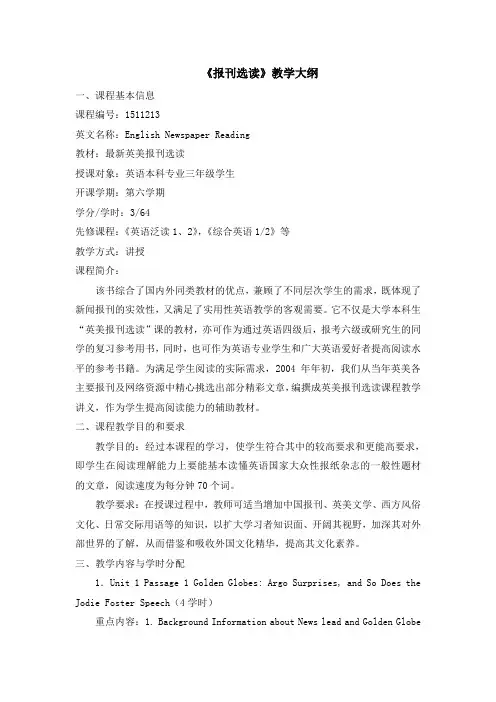
《报刊选读》教学大纲一、课程基本信息课程编号:1511213英文名称:English Newspaper Reading教材:最新英美报刊选读授课对象:英语本科专业三年级学生开课学期:第六学期学分/学时:3/64先修课程:《英语泛读1、2》,《综合英语1/2》等教学方式:讲授课程简介:该书综合了国内外同类教材的优点,兼顾了不同层次学生的需求,既体现了新闻报刊的实效性,又满足了实用性英语教学的客观需要。
它不仅是大学本科生“英美报刊选读”课的教材,亦可作为通过英语四级后,报考六级或研究生的同学的复习参考用书,同时,也可作为英语专业学生和广大英语爱好者提高阅读水平的参考书籍。
为满足学生阅读的实际需求,2004年年初,我们从当年英美各主要报刊及网络资源中精心挑选出部分精彩文章,编撰成英美报刊选读课程教学讲义,作为学生提高阅读能力的辅助教材。
二、课程教学目的和要求教学目的:经过本课程的学习,使学生符合其中的较高要求和更能高要求,即学生在阅读理解能力上要能基本读懂英语国家大众性报纸杂志的一般性题材的文章,阅读速度为每分钟70个词。
教学要求:在授课过程中,教师可适当增加中国报刊、英美文学、西方风俗文化、日常交际用语等的知识,以扩大学习者知识面、开阔其视野,加深其对外部世界的了解,从而借鉴和吸收外国文化精华,提高其文化素养。
三、教学内容与学时分配1.Unit 1 Passage 1 Golden Globes: Argo Surprises, and So Does the Jodie Foster Speech(4学时)重点内容:1. Background Information about News lead and Golden GlobeAward---it is an accolade bestowed by the 93 members of the Hollywood Foreign Press Association (HFPA) recognizing excellence in film and television, both domestic and foreign.2. To grasp the main structure and main idea of the passage:Para.1 IntroductionPara.2-16 Motion Picture AwardsPara.17-23 Television Awards3. To master the following language points:Juggernaut doom slots off-colorAbout the introduction of several movies教学方法:语言自然学习法,兴趣引导法课后作业:1.How much do you know about the Golden Globes and the Academy Award? Write them down.2.Passage 2 The Age of Obama (4学时)重点内容:1. Background Information about forms of news report: The chronological form, the suspend interest form, the interpretative reporting form2. To grasp the main structure of the passage:Para.1 Time roughs up PresidentsPara.2-5 Why presidents age quicklyPara.6-9 The only known cure3. To let students make a speech教学方法:兴趣引导法课后作业:Finish the reading comprehension part3. Unit 2 Passage 1 The Magician—Steve Jobs(4学时)重点内容:1. Background Information about Steve Jobs2. To grasp the main structure of the passage:Para.1-2 Jobs’ AchievementPara.3-5 Rich Experience of JobsPara.6-8 Factors accounting for Jobs’ Success3.To master the following language points:Conjure up give sb the edge turn out a range ofLet students imitate Jobs’speech in Stanford.教学方法:倒插柳教学法,兴趣引导法课后作业:Compare the similarities and differences between Steve Jobs and Bill Gates.4. Passage3 Whitney Houston重点内容:1. Background Information about Whitney Houston2. To discuss and debate the life of Whitney Houston3. To master the following language points:String-lush come along an instant sensation launch intoGod-daughter Billboard教学方法:案例式教学法课后作业:let students learn an English song5.Unit 3 Passage 1 Round Up the Gu ns! Or Don’t(4学时)重点内容:1. Background Information about President Obama’s Gun Control2. To grasp the main structure of the passage:Para.1-2 Introduction the background of gun controlPara.3-6 Analysis why Obama pushed forward the gun controlPara.7 Conclusion3. To master the following language points:倒装语序中有完全倒装(full inversion )和部分倒装(partial inversion )。
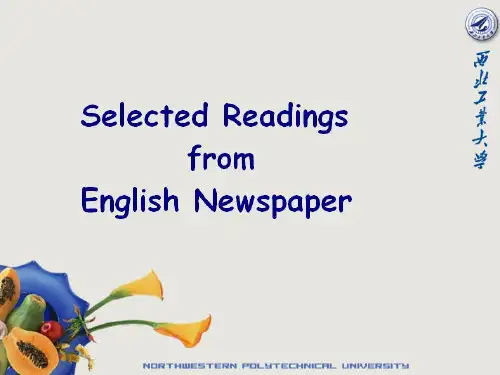


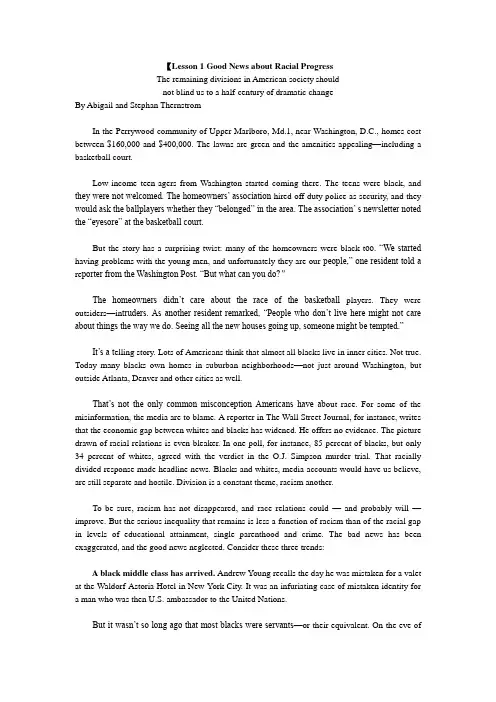
【Lesson 1 Good News about Racial ProgressThe remaining divisions in American society shouldnot blind us to a half-century of dramatic changeBy Abigail and Stephan ThernstromIn the Perrywood community of Upper Marlboro, Md.1, near Washington, D.C., homes cost between $160,000 and $400,000. The lawns are green and the amenities appealing—including a basketball court.Low-income teen-agers from Washington started coming there. The teens were black, and they were not welcomed. The homeowners’ association hired off-duty police as security, and they would ask the ballplayers whether they “belonged” in the area. The association’ s newsletter noted the “eyesore” at the basketball court.But the story has a surprising twist: many of the homeowners were black t oo. “We started having problems with the young men, and unfortunately they are our people,” one resident told a re porter from the Washington Post. “But what can you do?”The homeowners didn’t care about the race of the basketball players. They were outsiders—in truders. As another resident remarked, “People who don’t live here might not care about things the way we do. Seeing all the new houses going up, someone might be tempted.”It’s a t elling story. Lots of Americans think that almost all blacks live in inner cities. Not true. Today many blacks own homes in suburban neighborhoods—not just around Washington, but outside Atlanta, Denver and other cities as well.That’s not the only common misconception Americans have ab out race. For some of the misinformation, the media are to blame. A reporter in The Wall Street Journal, for instance, writes that the economic gap between whites and blacks has widened. He offers no evidence. The picture drawn of racial relations is even bleaker. In one poll, for instance, 85 percent of blacks, but only 34 percent of whites, agreed with the verdict in the O.J. Simpson murder trial. That racially divided response made headline news. Blacks and whites, media accounts would have us believe, are still separate and hostile. Division is a constant theme, racism another.To be sure, racism has not disappeared, and race relations could —and probably will —improve. But the serious inequality that remains is less a function of racism than of the racial gap in levels of educational attainment, single parenthood and crime. The bad news has been exaggerated, and the good news neglected. Consider these three trends:A black middle class has arrived. Andrew Young recalls the day he was mistaken for a valet at the Waldorf-Astoria Hotel in New York City. It was an infuriating case of mistaken identity for a man who was then U.S. ambassador to the United Nations.But it wasn’t so long ago that most blacks were servants—or their equivalent. On the eve ofWorld War II, a trivial five percent of black men were engaged in white-collar work of any kind, and six out of ten African-American women were employed as domestics.In 1940 there were only 1,000 practicing African-American lawyers; by 1995 there were over 32,000, about four percent of all attorneys.Today almost three-quarters of African-American families have incomes above the government poverty line. Many are in the middle class, according to one useful index—earning double the government poverty level; in 1995 this was $30,910 for a two-parent family with two children and $40,728 for a two-parent family with four children. Only one black family in 100 enjoyed a middle-class income in 1940; by 1995 it was 49 in 100. And more than 40 percent of black households also own their homes. That’ s a huge change.The typical white family still earns a lot more than the black family because it is more likely to collect two paychecks. But if we look only at married couples—much of the middle class—the white-black income gap shrinks to 13 percent. Much of that gap can be explained by the smaller percentage of blacks with college degrees, which boost wages, and the greater concentration of blacks in the South, where wages tend to be lower.Blacks are moving to the suburbs. Following the urban riots of the mid-1960s, the presidential Kerner Commission14 concluded that the nation’ s future was menaced by “accelerating segregation”—black central cities and whites outside the core. That segregation might well blow the country apart, it said.It’ s true that whites have continued to leave inner cities for the suburbs, but so, too, have blacks. The number of black suburban dwellers in the last generation has almost tripled to 10.6 million. In 1970 metropolitan Atlanta, for example, 27 percent of blacks lived in the suburbs with 85 percent of whites. By 1990, 64 percent of blacks and 94 percent of whites resided there.This is not phony integration, with blacks moving from one all-black neighborhood into another. Most of the movement has brought African-Americans into neighborhoods much less black15 than those they left behind, thus increasing integration. By 1994 six in ten whites reported that they lived in neighborhoods with blacks.Residential patterns do remain closely connected to race. However, neighborhoods have become more racially mixed, and residential segregation has been decreasing.Bigotry has declined. Before World Was ft, Gunnar Myrdal16 roamed the South researching An American Dilemma, the now-classic book that documented17 the chasm betwe en the nation’s ideals and its racial practices, hi one small Southern city, he kept asking whites how he could find “Mr. Jim Smith,” an African-American who was principal of a black high school. No one seemed to know who he was. After he finally found Smith, Myrdal was told that he should have just asked for “Jim.” That’ s how great was white aversion to dignifying African-Americans with “Mr.” Or “Mrs.”Bigotry was not just a Southern problem. A national survey in the 1940s asked whether “Ne-groes shoul d have as good a chance as white people to get any kind of job.” A majority of whites said that “white people should have the first chance at any kind of job.”19. Such a question would not even be asked today. Except for a lunatic fringe18, no whites would sign on to such a notion.1920. In 1964 less than one in five whites reported having a black friend. By 1989 more than two out of three did. And more than eight often African -Americans had a white friend.21. What about the last taboo?20 In 1963 ten percent of whites approved of black-white dating; by 1994 it was 65 percent. Interracial marriages? Four percent of whites said it was okay in 1958; by 1994 the figure had climbed more than elevenfold, to 45 percent. These surveys measure opinion, but behavior has also changed. In 1963 less than one percent of marriages by African- Americans were racially mixed. By 1993, 12 percent were.22. Today black Americans can climb the ladder to the top.21 Ann M. Fudge is already there; she’s in charge of manufacturing, promotion and sales at the $2.7-billion Maxwell House Coffee and Post Cereals divisions of Kraft Foods.22 So are Kenneth Chenault, president and chief operating officer at American Express23 and Richard D. Parsons, president of Time Warner, Inc.24 After the 1988 Demo-cratic Convention25, the Rev. Jesse Jackson26 talked about his chances of making it to the White House. “I may not get there,” he said “But it is possible for our children to get there now.”23. Even that seems too pessimistic. Consider how things have improved since Colin and Alma Powell27 packed their belongings into a V olkswagen28 and left Fort Devens, Mass., for Fort Bragg, N. C. “I remember passing Woodbridgc, Va.,” General Powell wrote in his autobiogra phy, “and not finding even a gas-station bathroom that we were allowed to use.” That was in 1962. In 1996 reliable polls suggest he could have been elected President.24. Progress over the last half-century has been dramatic. As Corctta Scott King wrote not long ago, the ideals for which her husband Martin Luther King Jr. died, have become “deeply embedded in the very fabric of America29.”From Reader’s Digest, March, 1998V. Analysis of Content1. According to the author, ___________A. racism has disappeared in AmericaB. little progress has been made in race relationsC. media reports have exaggerated the racial gapD. media accounts have made people believe that the gap between blacks and whites has become narrower2. What the Kerner Commi ssion meant by “accelerating segregation” was that __________A. more and more whites and blacks were forced to live and work separatelyB. more and more blacks lived in the central cities, and whites outside the coreC. more and more whites lived in the central cities, and blacks outside the coreD. nowadays more and more blacks begin to live in the suburbs3. The last taboo in the article is about ____________.A. political status of America’s minority peopleB. economic status of America’ s minori ty peopleC. racial integrationD. interracial marriages4. Gunnar Myrdal kept asking whites how he could find “Mr. Jim Smith,” but no one seemed to know who he was, because _____________.A. there was not such a person called Jim SmithB. Jim Smith was not famousC. the whites didn ‘t know Jim SmithD. the white people considered that a black man did not deserve the title of “Mr.”5. In the author’s opinion, _A. few black Americans can climb the ladder to the topB. Jesse Jackson’ s words in th is article seemed too pessimisticC. Colin Powell could never have been elected PresidentD. blacks can never become America’ s PresidentVI. Questions on the Article1. Why were those low-income teen-agers who came to the Perrywood community consid-ered to be “the eyesore”?2. What is the surprising twist of the story?3. According to this article, what has caused much of the white-black income gap?4. Why did the presidential Kerner Commission conclude that the nation’ s future was menaced by “accelerating segregation”?5. Why wouldn’t questions as “Should negroes have as good a chance as white people to get any kind of job?” be asked today?Topics for Discussion1. Can you tell briefly the dramatic progress in the status of America’ s minority p eople over the last half-century?2. Do you think the article is unbiased? What do you think of the author s view on the African-Americans?1. amenity: n. A. The quality of being pleasant or attractive; agreeableness. 怡人:使人愉快或吸引人的性质;使人愉快 B. A feature that increases attractiveness or value, especially of a piece of real estate or a geographic location.生活福利设施;便利设施:能够增加吸引力或价值的事物,特别是不动产或地理位置⊙ We enjoy all the -ties of home life. 我们享受家庭生活的一切乐趣。

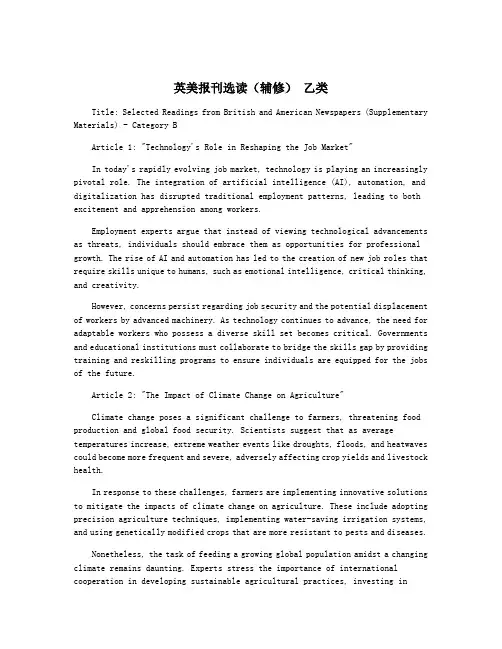
英美报刊选读(辅修)乙类Title: Selected Readings from British and American Newspapers (Supplementary Materials) - Category BArticle 1: "Technology's Role in Reshaping the Job Market"In today's rapidly evolving job market, technology is playing an increasingly pivotal role. The integration of artificial intelligence (AI), automation, and digitalization has disrupted traditional employment patterns, leading to both excitement and apprehension among workers.Employment experts argue that instead of viewing technological advancements as threats, individuals should embrace them as opportunities for professional growth. The rise of AI and automation has led to the creation of new job roles that require skills unique to humans, such as emotional intelligence, critical thinking, and creativity.However, concerns persist regarding job security and the potential displacement of workers by advanced machinery. As technology continues to advance, the need for adaptable workers who possess a diverse skill set becomes critical. Governments and educational institutions must collaborate to bridge the skills gap by providing training and reskilling programs to ensure individuals are equipped for the jobs of the future.Article 2: "The Impact of Climate Change on Agriculture"Climate change poses a significant challenge to farmers, threatening food production and global food security. Scientists suggest that as average temperatures increase, extreme weather events like droughts, floods, and heatwaves could become more frequent and severe, adversely affecting crop yields and livestock health.In response to these challenges, farmers are implementing innovative solutions to mitigate the impacts of climate change on agriculture. These include adopting precision agriculture techniques, implementing water-saving irrigation systems, and using genetically modified crops that are more resistant to pests and diseases.Nonetheless, the task of feeding a growing global population amidst a changing climate remains daunting. Experts stress the importance of international cooperation in developing sustainable agricultural practices, investing inclimate-resilient infrastructure, and supporting farmers in adopting climate-smart strategies.Article 3: "The Rise of E-commerce: Transforming Retail"The rise of e-commerce has revolutionized the retail industry, altering shopping habits and challenging traditional brick-and-mortar stores. Online shopping offers convenience, a wide variety of products, and competitive pricing, attracting a growing number of consumers.This shift has led to a decline in footfall at physical stores, prompting retailers to adapt or face obsolescence. Many have responded by integrating online and offline shopping experiences, offering click-and-collect services, and creating interactive in-store experiences.While e-commerce offers numerous benefits, concerns have been raised regarding the impact on local businesses and the loss of personalized customer service. However, retailers who successfully embrace technology and leverage data analytics can enhance their competitiveness and offer personalized recommendations to customers.In conclusion, technology, climate change, and e-commerce are transforming various aspects of society, ranging from the job market to agriculture and retail. Adapting to these changes requires a combination of embracing new opportunities, addressing challenges, and fostering collaboration between various stakeholders.。
大学《英美报刊选读》单词汇总第一篇:大学《英美报刊选读》单词汇总一、单词(reading one)1、Part One: The NewspaperUnit OneInternational NewsCompounds n.大院,有围墙的房群Prostitution n.卖淫Nudity n.裸体,裸露Come-back n.卷土重来Erotica n.色情书、画Smut n.黄段子Racy adj.下流的,不雅的Crack-down n.打击Pornography n.淫秽,色情Venue n.场所Plugged-in adj.(喻)触网的Periodically adv.定期的Straight and narrow 正当、诚实、正派Deprave v.腐化,堕落Resurgence n.重新抬头Authoritarian adj.权威的Lovelorn adj.失恋的Strait-laced adj.一本正经的,古板的Law-breaker n.违法者Mores n.传统,习俗Obscene adj.淫秽的Loosen up 放松,松弛Censor v.检查,审查Air-waves n.无线电波Epidemic n.流行病Blush v.脸红Ubiquitous adj.无处不在Unit TwoNational Report Payout n.付出款项Mirror v.反映Slam v.猛力撞击Tailored adj.作过修改的;简单实用的Fuel v.刺激,激起Ward off 避开;避免Divisiveness n.分裂;不和;分歧Deflect v.转移,引开Statute n.法令Shackle v.束缚;阻挠Sentiments n.意见;观点Elude v.躲避;避开Flat-award n.固定赔偿金Forgo v.放弃Recipient n.接受者Enact v.制定或通过(法令)Sue v.提起诉讼Grieving adj.感到悲伤的Curtail v.削减Collateral adj.附带的Litigate v.诉讼Offset n.补偿Equitable adj.公平合理的Curb n.控制,约束Crippling adj.极有害的Defunct adj.不再使用的Waive v.放弃Magnitude n.规模Unit ThreeBusiness WorldInnovative adj.创新的,革新的File for 申请Oligarchy n.寡头政治,寡头统治集团Underwrite v.认购(公司)尚未出售的新股票;包销Cream n.精华,精粹Wrest v.夺取,费力取得Auction n.拍卖;标售Bypass v.绕过,越过Pull the strings 操纵事件或他人行为Bid for 出价Pull off(成功火箭哭地)完成,做成Batch n.一批,一组Tank v.储存,囤积Precedent n.先例,前例Treasury bond(美国财政部发行的)证券Synonym n.同义词Allocate v.分配,配给Oxycodone n.羟基二氢可待因酮Hedge fund 套利基金Hydrocodone n.二氢可待因酮Pension n.养老金,抚恤金,退休金 Amphetamine n.氨基丙本,安非他明(解除忧郁、疲劳的药)Skunk n.臭鼬Orchestrate v.使和谐地结合起来 Deficit n.不足,欠缺Merchandise n.商品,货品Hyperactivity n.极度活跃Sabotage v.破坏,阻挠Pharmaceutical adj.制药的,应用药物的Ardent adj.热心的,热情的Clout n.势力,影响力,权势Extract v.提取,榨出Garner v.积累,获得Monopoly n.垄断,独占Unit FourThe MetroLongevity n.长寿,长命Broccoli n.花椰菜,球花甘蓝Scary adj.易受惊的,胆怯的Bogeyman n.鬼怪,骇人的东西Impoverish v.使贫困Cater for 满足需求Dire adj.可怕的,不祥的Skim off 除去,(为逃税等而)瞒报Bail out v.帮助脱离困境Risk-pooling n.风险集中Unwarranted adj.无保证的,不确定的,不必要的Means testing 对(失业或残疾者等)进行经济情况调查(已确定是否给予补助)Laud v.赞美,称赞Rhetoric n.辞令,虚夸Discount with 不信,漠视Imminent adj.临近的,逼近的Demutualisation n.利化,互利改组公司(公司大部分股份转给雇员或主顾)Appreciably adv.可估计的,明显的Lurch v.突然倾斜,改变Terminology n.术语Fix n.补救方法,应急措施Wonk n.刻苦用功的学生Actuary n.保险精算师,保险业务计算员 Disincentive n.(对经济发展等)起抑制作用的,制止因素Odd adj.额外的,零星的Prone adj.容易的,易于Obesity n.肥胖,肥胖症Wholesale adj.大规模的,不加区别的Unit FiveScience & TechnologyStigma n.污名,耻辱Cellular n.蜂窝式分区无线,通讯Aplomb n.沉着,泰然Demographic adj.人口统计学的Missive n.信件Adroitness n.熟练Hunt and peck 看着键盘打字Manifest v.表明Boom v.繁荣,兴隆Dexterity n.灵巧,机敏Hierarchy n.层次,等级Piranha n.水虎鱼Digit n.手指Genera(pl of genus)n.类,属With the advent of 随着……的出现,到来Stature n.(凭才能和成就而获得的)声誉Ferocious adj.凶猛的Envision v.想象,预想Banishment n.流放,放逐Snag n.阻碍Renaissance n.复兴Banter n.善意的玩笑Prowess n.威力Tendon n.[解]腱Opportune adj.恰好的,适宜的Manifold adj.多方面的,多种形式的Unlearn v.忘却Callus n.老茧Foothold n.立足点Tough sth.Out 从(困难)中硬挺过来Unobtrusive adj.不明显的Unit SixArt & LivingMilk v.从……中获利,获益;从……中榨取Compliment n.敬意Playbook n.剧本Soundtrack n.(电影)配乐Embrace n.接受,利用Hit n.轰动一时的人物,风行一时的东西Nerve-wracking adj.使人心烦的,伤脑筋的Dicier adj.更冒险的,更危险的Console n.(计)控制台Format n.程序,格式Render v.致使,使成Rule of thumb 经验得来的法则Take a chance 碰运气,冒险Tie-in n.搭配在一起出售的货品Sure-fire adj.稳操胜券的Sequel n.续集,续篇Flail v.鞭打,抽打Shakeout n,(行情下跌中的盈利微薄行业、产品等的)被淘汰,裁汰Stave off 延缓,避开Hedge v.避免,防范Profligate adj.恣意的,极其浪费的 Cushion n.垫子,保护物,缓冲装置Ancillary adj.辅助的,从属的Rental n.租金收入,租金额Spin-off n.副产品,衍生产品Bomb v.(美俚)惨败Mark down 减价,降价Legitimate adj.合法的,正规的Rival v.与……竞争,对抗Scramble v.争取,争夺Subscription n.订约,订阅,订购Pitch v.努力推销Juggernaut n.使人盲目崇拜并为之牺牲的事物;不可抗拒的力量Model on 模仿,效仿Franchise n.特许权,特许经营权Flat-footed adj.无准备的Platinum n.铂,白金Keep one’s edge 保持优势Consolidation n.合并,联合Devour v.吞食Portfolio n.公事包,文件夹Conglomerate n.由许多公司组成的大公司,企业集团Unit SevenSports & FitnessTrivial adj.琐细的,微不足道的Referendum n.全民投票Kinesiology n.[体]运动机能学Obsolete adj.废弃的,过时的Oddity n.怪人,奇特的东西Hone v.磨练;训练Twitch n.急扯,猛地一拉Sprinter n.赛跑选手Grab hold of 抓紧,掌握Dystrophy n.营养不良Steroid n.类固醇Therapy n.治疗Rogue n.流氓;无赖Innate adj.先天的,天生的Paralympics n.伤残奥运会Profile n.侧面;轮廓;概况Bet n.预言Tendon n.[解]腱Deleterious adj.有害的,有毒的Anarchy n.无政府状态,混乱状态 Freak n.畸形或不正常的人或动物Be inundated sb.(with sth.)给予某人很多事情使之难以应付;是某人不胜负荷Unit EightFeaturesPonder v.考虑;深思Gelato n.意大利胶凝冰棍Vendor n.摊贩;卖主Rite n.隆重的仪式或典礼Siesta n.午后的小睡Villa n.带有大花园的别墅 Repeal v.废止(法规等)Calvinism n.加尔文主义 Dehumanize v.非人化Nurture v.培养;养育Eclipse v.使相形见绌;黯然失色Sloth n.树懒(动物)Frenetic adj.发狂的Fresco n.壁画Disentangle v.摆脱Enervate v.使(人)失去力量或精力Anomaly n.不合规则;异常事物Confluence n.汇合,汇集 Skip v.不参加,不做Ideology n.思想意思Take a toll/ take its toll of something 造成损失、毁坏等Unit NineEditorials & OpinionsUnprecedented adj.史无前例的,空前的Pitch n.程度Flip side 反面Loom v.隐现,迫近Swathes of 大片Fell v.砍伐Accentuate v.强调Endemic v.地方病Sanitation n.卫生设施Epidemic n.流行病Degradation n.退化,降级Sustainable adj.可持续的Patriarch n.家长Devolve v.(把权力、工作)移交某人Vested interest 特权Tip off 向……泄露,告诫Saga n.传奇Tributary n.支流T oxin n.[生]毒素Tannery n.制革厂Torrential adj.奔流的Mound n.土堆,土丘Chlorinate v.用氯消毒Stagnate adj.因不流动而变臭的或有味的Insatiable adj.不知足的,贪得无厌的Dioxin n.[化]二氧(杂)芑Levy n.征税Signatory n.签名者Legitimacy n.合法(性),合理(性)Hierarchy n.层次,等级Unit TenHealth & EnvironmentContagious adj.传染的,有传染性的 Obesity n.肥胖,过度肥胖Biotech n.应用生物Affiliate v.隶属,关联 Unravel v.揭开,弄清Leptin n.瘦体素基因Hormone n.荷尔蒙Calorie n.卡路里Mutation n.改变,突变Cholesterol n.胆固醇Triglyceride n.三酸甘油酯Adenovirus n.腺病毒Antibody n.抗体Counterpart n.对应体Lipoprotein n.脂蛋白Fringe adj.从属的,次要的,附加的Cutting-edge adj.最先进的,前沿的 Valid adj.有效的Shore v.支撑,稳住Pan(out)v.证明(是),结果(是)Groundbreaking adj.开天辟地的,创业的Ulcer n.溃疡2、Part Two: The MagazineStand on 坚持Be entitled to 有做某事的权利 Egotism n.自我中心,自私自利Rabble n.乱纷纷的人群,乌合之众Assent v.同意,赞成Dependant n.依赖他人生活着Metaphysical adj.形而上学的,抽象的Petitioner n.上诉人 Sphere n.领域,范围Bureaucrat n.贵族Dissatisfied adj.感到不满的,不满足的Complainant n.原告Adjudicator n.裁判,评论员 Doubly adv.加倍的,双重地Redress n.纠正,补偿Aggrieved adj.愤恨的,愤愤不平的Sap v.逐渐消耗Beneficiary n.受益者,受益人Entice v.诱惑,诱使Prohibition n.禁止,阻止Labyrinth n.迷宫,迷津Substantive adj.真实的,实在的,实际的Preclude v.排除Psychiatrically adv.精神病的 In vitro fertilization 体外受精Dire adj.可怕的Every other 所有其他的DoH(Department of Health)卫生部 Irrespective of 无论Bedlam n.疯人院Paralysis n.瘫痪Reverberation n.回响,反射Deterioration n.恶化Abstraction n.抽象概念 Connotation n.涵义Beloved adj.心爱的Inalienability n.不可剥夺Allegedly adv.据说,根据(人们)宣称Unconditional adj.无条件的Observance n.遵守Abrogate v.废止,取消Deem v.认为Ill-conduct n.不良行为Unassailable adj.不可攻破的Tangible adj.明确的,确切的,真实的Tower block 高层建筑,摩天大楼Dialectic adj.辩证关系Vaunted adj.吹嘘的,夸耀的 Ingratitude n.忘恩负义Feral adj.野性的Grievance n.牢骚,不满,怨恨Permissive adj.放任的,放纵的3、Part Three: News on the WebParalegal n.律师的专职助手Do over 重做,重复Internship n.实习,实践Counselor n.顾问,参谋 Tuition n.学费Exploration n.探索,探究 Fare v.进展,过日子Dissuade v.劝阻Contemplate v.打算,考虑Unforgiving adj.无情的,不够宽容的 Drift n.放任自流Lose out on something 不成功,受损失 Societal adj.社会的Mired adj.陷入泥潭的Moderator n.主持者Squander v.浪费,虚度Blow it 错过(良机)Marketable adj.适应市场的 Mythology n.神话Anthropology n.人类学4、Part Four: Broadcasting & TelevisionSwarm n.大群人,人群v.大群地移动 Dignitary n.显要人物;权贵 Sheikh n.伊斯兰教的宗教领袖,教主 Casket n.棺材Hearse n.灵车Drape v.覆盖Caisson n.弹药箱,弹药车Procession n.行进,前进 Mourner n.哀悼者Guarantee v.保证Revitalize v.使再充满活力Reinvigorante v.再鼓舞,再激励Mobilize v.动员Corruption n.腐败Priority n.优先(考虑的事)Obstacle n.障碍Inauguration n.就职典礼Eulogy n.颂词,颂文Ambassador n.大使Mast n.旗杆;桅杆Tributes n.表示敬意或称赞的行动、言语或礼物5、Part Five: The MovieSpider-man n.蜘蛛侠Guts n.勇气与决心;胆量;魄力 Give sb.A hand 帮助某人Pish n.呸(表示不愉快或不耐烦)Water under the bridge 覆水难收Make a move 采取行动Give away 赠送Cookbook n.烹饪书,食谱Mixer n.搅拌机Self-sacrificing adj.自我牺牲的 Line up for sth.排队做某事Glimpse n.一瞥Get a glimpse of sb.瞥见Strain v.竭力;用全力(做某事)Pal n.朋友Jerk n.蠢人Play tricks on 捉弄;开……的玩笑 Peel(sth.)off 把……脱掉 Do a number on 伤害某人的感情;嘲弄Lay a finger on sb./ sth.(即使轻轻)触碰某人Whereabouts n.下落;行踪fiancée n.未婚妻Menace n.威胁;恐吓Prosecute v.检举、告发 Arachnid n.蛛形纲动物(包括蜘蛛、蝎子、蜱、螨等)Spine n.勇气Scurry v.小步疾跑Monster n.巨大、丑陋、可怕的怪物第二篇:英美报刊新闻标题 1.Explosion heard near Iranian Parliament2,President:Sino-Americanrelationship副links co nductive to world peace and stability3, BMW’s problem child4,spent fuel shipment/Nuclear waste shipment副Germany to lift ban on transport of nuclear waste5,To save or Not to save6,The co-operation between the Government7Professor leaves $4M to his colledge,8Fomer bushaffical kills son abd self9US population figures to hit 300M10 Iraq’s Olympic rep kidnapped11 Man sentenced to 150 years12Us Russia fail to agree on WTO membership13Infustrial dream fades third worldrevives farms 术语《创世纪》Admissions offices招生办Advanced degree高等学位All works of lives各行各业Alumni connections校友联谊会Alumni校友Assault突袭Auction拍卖Ballet lesson芭蕾课Barebones budget少得可怜的预算Beautiful spot胜地Benign 和蔼的Blare-to make a very coud,unpleasant noiseBlind date相亲Bold theory斗胆的理论Boozy嗜酒的Buddhist grottoes佛教石窟Buoyant开朗的活泼的Evolution wars进化论之战Cable car缆车Cambrian寒武纪时代Carbon dioxide 二氧化碳Carte-balance全权,绝对的自由Cash cow摇钱树Center heat-supply集体供暖CEO:chief executive officer行政主管Chance mutations变异Chief operating officer运营主管Christian fundamentalist基督教原教旨主义者Churn搅拌器Clampen-to make sad or dullClique帮派Clinical psychology 内科心理学Clot凝结Commercialism商业主义Communist regime 共产党政府Consulting-firm顾问公司Controversy争议Correspondence education函授教育Counterpart职位相当的人Cramp-to keep in a narrow spaceCrass commercialism唯利是图Creationism神秘论Criteria评判、标准Critical inquiry批评性探索Critique批评Cultural relics文化遗产Daring topic大胆的话题Darwin’s theory达尔文进化论(origin of species物种起源/natural selection自然选择/survivalof the fittest适者生存)Dead souls“老”不死的Debt specialist债务分析家Dilemma 进退维谷Distance education class远程教育Document文件、记录记载Dot-com world网络世界Edge渴望Educational environment 学习环境Extra curricular activities课外活动Elite college精英大学Elite university一流大学Elite精英Embolden使..勇敢Emulation-desire or ambition to equal or surpass仿效、竞争Erode-to wear away磨损消逝Established有建树的人Establishment住所景点Ethnic favor民族特色Exquisite精美的高雅的Face to face instruction面对面指导Faith-based science以宗教为基础的科学Fossil record化石标本Fossil化石Full scholarships全额奖学金Gainsay反驳、否认GE:General Electric通用电气公司Genetic code 遗传密码Getty conservation Institute文物保护中心Go online上网Gobi Desert戈壁滩Gravitate受吸引Gray brick灰砖大学Haphazard 偶然的Hard-core defender坚决维护着Have access to有权进入HBS:Harvard Business School哈佛商学院Hiker and backpacker徒步旅行的人Identical gene相同基因Identityformation个性形成Indigenous life本土生活Information-based economy信息经济Infrastructure基础设施Intelligent design智慧、巧妙的设计Investment bank投资银行Libertarians鼓吹公民自由Log in登陆Lose its edge失去优势Lucrative offers丰厚的报酬Magazine rankings杂志排行榜Management expertise管理专业知识Massive military军事现代化MBA:Master of Business Administration工商管理硕士Meet love with hate以德报怨Mind-numb情感冷漠MoGao grotto莫高窟Moisture潮气Multinational company 跨国公司Mural壁画Navigate the local bureaucracy驾驭地方官僚主义Nightmare 噩梦,梦魇Non scientific alternatives非科学选择Non-renewable resource不可再生资源Oasis沙漠中的绿洲On-campus master’s program在校研究生课程Opponent反对论Outlook人生观Overhaul-to examine thoroughly彻底改革Peer-reviewed journal 同行专业评论杂志Pitfall隐患,易犯的错误Plight困境Preside主持Prime-time黄金时段Private university 私立大学Proponent支持者Pseudo science伪科学Public amusement公共娱乐Public university公立大学Grotto石窟Rank Three三教九流Ratio比率Reconcile使和解,调停Release释放、出版发行Remote enrolment远程注册Returnee归国留学生Rigorous 严峻的艰苦的Rollicking-noisy , cheerful喧闹快乐的Run the risk of being guinea pigs实验主体SAT scores数学/语文公测School board学校董事会Scribble down乱写乱涂Script手稿/伶牙俐齿Selective college重点大学Self-discipline自我约束Seminal works初级工作Seminal work胚胎Seminal精液的生殖的Senior fellow资深研究院Sensibility感觉、情感Sensitive issue敏感话题Separation of state and church政教分离Shift work倒班Silicon valley硅谷Silk Road 丝绸之路Start-ups新兴企业State-owned国营的Statue雕塑Step onto a university campus上大学Structure改革Superintend dent 教育局负责人Suspend-to temporarily prevent fromcontinuzing or being in force or effect暂停、中止Swarm蜂拥而至Symposium酒会,座谈会Tacky质量低劣的Teleconference电话会议T erra-cotta 土陶,粘土T est prep courses考前辅导班The delicate subject matter微妙的题材The lion’s share很大的比例The winner-Take-All Society胜者通吃的社会Think tangle智囊团Thwart阻止Tourist authorities旅游局Trek长途跋涉Turf battle势力范围UNESCO:United Nations Education Science Culture Organization 联合国教科文组织University Continuing Education Association大学成人教育Unveil揭示Upland高地Upper rungs上层职位Upsurge 急剧上升,增长Validation确认Venture capitalist风险投资家Vigorous有精力的Violate违背,侵犯Virtual class虚拟课程Vitality生命力、活力World heritage世界遗产World relics世界遗产第三篇:英美报刊第一页美英报刊-背景知识1.加勒比海主要岛屿有:太平洋岛屿:马里亚群岛,夏威夷,关岛。
Home at last这是其中的一个通宵gabfests学生在毕业时,他们将友情,裸露最深的感觉。
只有这是更严重的:11同学聚集在公寓在哈佛商学院校园1999年5月,是中国的命运抗争。
包围着空啤酒瓶和包薯片,朋友们——所有来自中国大陆——正在讨论是否要回家了。
他们每个人都已经收到了来自美国顶尖的公司。
当然,中国发生了巨大变化的十年以来,他们中的大多数人都离开了。
政治和抗议仍是禁忌,但美国现在提供了更多的个人自由和经济的机会比以往任何时候都多。
和它急需精英经理喜欢他们。
张伟,一个活跃的29岁女性的梦想是成为中国的美国脱口秀主持人奥普拉·温芙瑞,恳求她的同学凭著他们回家。
“我们不会牺牲现在为了明天,”她说。
“我们应该马上做我们真正想做的事。
”这个词是纯粹的金钱,但他们证明预言。
在几周的时间里,也不愿在这房间里的最年轻的人——一个26岁的前国家数学冠军名叫哨Yibo——那里商业建议、出售他的财产留给了上海,他在那里举行中国版的网上拍卖巨人易趣。
在路上,他停下来休息一天在硅谷和说服投资者给他40万美元。
几周之后,同学镡海鹰回到上海拜访朋友开始之前一个银行的工作在纽约。
她从不使用她的回程机票到美国:邵说服她去参加他的公司的首席运营官。
三其他成员在一年之内的小团体——欢一茗,妮陈和赫伯特王建民——也回发射启动公司。
和张吗?她的工作是business-development降落在鲁珀特·默多克新闻集团在北京。
她也加班追求金钱的梦想。
一旦一个星期她主持一个受欢迎的电视脱口秀节目,在北京的主题是如此大胆艾滋病、药物滥用和——是的——网上约会。
长时间的中国学生聚集在HBS的,他们并不是寻找一个逃跑,但是他们最终的边缘。
经过多年的咨询公司,跨国公司或创业,所有的人都觉得需要更进一步的了解西方商业文化。
哈佛,中国学生迅速移聚在一起。
旧的手帮助新来的人学会开车,买菜,乘坐地铁。
三个人一起住在一所公寓里,因为他们煮中国菜,事情很快就成了。
The Sino-Japanese Naval War of 2012OK, it's probably not going to happen. But if it did, who would win?From Foreign Policy of August 24,2012Lord Wellington depicted the allied triumph(盟军的胜利)at Waterloo as "the nearest-run thing(最势均力敌的较量)you ever saw in your life." Wellington's verdict would describe the likely outcome should Chinese and Japanese forces meet in battle over theSenkaku/Diaoyu Islands, or elsewhere off the Northeast Asian seaboard. Such a fight appeared farfetched(牵强的,靠不住的)before 2010, when Japan's Coast Guard apprehended(逮捕)Chinese fishermen who rammed one of its vessels off the disputed islands, but it appears more likely now. After Japan detained and deported(扣押并遣送)Chinese activists who landed on the disputed islands in mid-August, a hawkish(鹰派的)Chinese major general(少将), Luo Yuan, called on China to dispatch(派遣)100 boats to defend the Diaoyus. In an op-ed(专栏版)published Aug. 20, the nationalistic Chinese broadsheet Global Times(环球时报的大幅纸张)warned, "Japan will pay a price for its actions ... and the result will be far worse than they anticipated."This is more than mere posturing(故作姿态). In July, China's East Sea Fleet(舰队)conducted an exercise simulating an amphibious(水陆两栖的)assault on the islands. China's leaders are clearly thinking about the unthinkable(未雨绸缪). And with protesters taking to the streets(上街游行)to smash(砸碎)Japanese cars and attack sushi restaurants, their people may be behind them(民众可能是政府强有力的后盾). So who would win the unlikely prospect of a clash of titan s in the Pacific(两位太平洋巨人): China or Japan?Despite Japan's latter-day(当今的)image as a military pushover(军事小国), a naval war would not be a rout(溃败)for China. While the Japanese postwar "peace" constitution (和平宪法)"forever renounces war as a sovereign right of the nation and the threat or use of force as means of settling international disputes,"(永远放弃自己作为主权国家使用武力解决国际纠纷的权力)the Japan Maritime Self-Defense Force (JMSDF) has accumulated several pockets of material excellence,(存有几幅好牌)such as undersea warfare, since World War II. And Japanese mariners(海员)are renowned for their professionalism. If commanders manage their human, material, (调兵遣将)and geographic advantages artfully, Tokyo could make a maritime war(海战)with China a close-run thing(旗鼓相当)-- and perhaps even prevail(更胜一筹).Past naval wars between the two rivals set the stage for today's island controversy. During the Sino-Japanese War of 1894-1895, a fleet engagement turned Asia's Sinocentric order upside down in an afternoon. The Imperial Japanese Navy, hurriedly cobbled together from imported hulls and components following Japan's Meiji Restoration, smashedChina's Beiyang Fleet, a force widely considered superior in material terms. The September 1894 Battle of the Yalu River was won by the navy with superior seamanship,gunnery, and morale. While Japan is no longer a rising power, the JMSDF has preserved a culture of human excellence.If a rerun of the Battle of the Yalu takes place, how would Japan's navy match up against China's? This is admittedly an improbable scenario. A straightforward China-on-Japan war is doubtful unless Beijing manages to isolate Tokyo diplomatically -- as wise practitioners of limited war attempt to do -- or Tokyo isolates itself through foolish diplomacy. Barring that, a conflict would probably ensnare the United States as an active combatant on the Japanese side. War is a political act -- "statesmanship directing arms," as naval historian Alfred Thayer Mahan puts it -- but let's discount politics for now and look at the prospects of war in strictly military terms, as a contest between Chinese and Japanese sea power.In raw numerical terms, there is no contest. Japan's navy boasts 48 "major surface combatants," ships designed to attack enemy main fleets while taking a pounding themselves. For the JMSDF these include "helicopter destroyers," or light aircraft carriers; guided-missile destroyers equipped with the state-of-the-art Aegis combat system, a combination radar, computer, and fire-control system found in frontline U.S. Navy warships; and an assortment of lesser destroyers, frigates, and corvettes. A squadron of 16 diesel-electric submarines augments the surface fleet. Juxtapose this against the PLA Navy's 73 major surface combatants, 84 missile-firing patrol craft, and 63 submarines, and the bidding appears grim for Japan. China's navy is far superior in sheer weight of steel.But raw numbers can be misleading, for three main reasons. First, as strategist Edward Luttwak has observed, weapons are like "black boxes" until actually used in combat: no one knows for sure whether they will perform as advertised. Battle, not t echnical specifications, is the true arbiter of military technology's value. Accurately forecasting how ships, planes, and missiles will perform amid the stresses and chaos of combat thus verges on impossible. This is especially true, adds Luttwak, when conflict pits an open society against a closed one. Open societies have a habit of debating their military failings in public, whereas closed societies tend to keep their deficiencies out of view. Luttwak was referring to the U.S.-Soviet naval competition, but it applies to Sino-Japanese competition as well. The Soviet Navy appeared imposing on paper. But Soviet warships on the high seas during the Cold War showed unmistakable symptoms of decay, from slipshod shiphandling to rusty hulls. The PLA Navy could be hiding something as well. The quality of the JMSDF's platforms, and its human capabilities, could partially or wholly offset the PLA's advantage of numbers.Second, there's the human variable in warfare. In his classic account, The Naval War of 1812, Theodore Roosevelt explained the U.S. Navy's success in single-ship duels against Britain's Royal Navy as a product of quality ship design and construction and superior fighting prowess: in other words, of material and human factors. The latter is measured in seamanship, gunnery, and the myriad of traits that set one navy apart from others. Mariners hone these traits not by sitting in port and polishing their equipment but by goingto sea. JMSDF flotillas ply Asian waters continually, operating solo or with other navies. The PLA Navy is inert by comparison. With the exception of a counter-piracy deployment to the Gulf of Aden that began in 2009, Chinese fleets emerge only for brief cruises or exercises, leaving crews little time to develop an operating rhythm, learn their profession, or build healthy habits. The human edge goes to Japan.And three, it's misleading to reduce the problem solely to fleets. There will be no purely fleet-on-fleet engagement in Northeast Asia. Geography situated the two Asian titans close to each other: their landmasses, including outlying islands, are unsinkable aircraft carriers and missile firing platforms. Suitably armed and fortified, land-based sites constitute formidable implements of sea power. So we need to factor in both countries' land-based firepower.Japan forms the northern arc of the first island chain that envelops the Asian coastline, forming the eastern frontier of the Yellow and East China seas. No island between the Tsushima Strait (which separates Japan from Korea) and Taiwan lies more than 500 miles off China's coast. Most, including the Senkakus/Diaoyus, are far closer. Within these cramped waters, any likely battleground would fall within range of shore-based firepower. Both militaries field tactical aircraft that boast the combat radius to strike throughout the Yellow and East China seas and into the Western Pacific. Both possess shore-firedanti-ship cruise missiles (ASCMs) and can add their hitting power to the mix.There are some asymmetries, however. PLA conventional ballistic missiles can strike at land sites throughout Asia, putting Japanese assets at risk before they ever leave port or take to the sky. And China's Second Artillery Corps, or missile force, has reportedly fielded anti-ship ballistic missiles (ASBMs) able to strike at moving ships at sea from the mainland. With a range estimated at more than 900 miles, the ASBM could strike anywhere in the China seas, at seaports throughout the Japanese islands, and far beyond.Consider the Senkakus, the hardest assets to defend from the Japanese standpoint. They lie near the southwestern tip of the Ryukyu chain, closer to Taiwan than to Okinawa or Japan's major islands. Defending them from distant bases would be difficult. But if Japan forward-deployed Type 88 ASCMs -- mobile, easily transportable anti-ship weapons -- and missile crews to the islets and to neighboring islands in the Ryukyu chain, its ground troops could generate overlapping fields of fire that would convert nearby seas into no-go zones for Chinese shipping. Once dug in, they would be tough to dislodge, even for determined Chinese rocketeers and airmen.Whoever forges sea, land, and air forces into the sharpest weapon of sea combat stands a good chance of prevailing. That could be Japan if its political and military leaders think creatively, procure the right hardware, and arrange it on the map for maximum effect. After all, Japan doesn't need to defeat China's military in order to win a showdown at sea, because it already holds the contested real estate; all it needs to do is deny China access.If Northeast Asian seas became a no-man's land but Japanese forces hung on, the political victory would be Tokyo's.Japan also enjoys the luxury of concentrating its forces at home, whereas the PLA Navy is dispersed into three fleets spread along China's lengthy coastline. Chinese commanders face a dilemma: If they concentrate forces to amass numerical superiority during hostilities with Japan, they risk leaving other interests uncovered. It would be hazardous for Beijing to leave, say, the South China Sea unguarded during a conflict in the northeast.And finally, Chinese leaders would be forced to consider how far a marine war would set back their sea-power project. China has staked its economic and diplomatic future in large part on a powerful oceangoing navy. In December 2006, President Hu Jintao ordered PLA commanders to construct "a powerful people's navy" that could defend the nation's maritime lifelines -- in particular sea lanes that connect Indian Ocean energy exporters with users in China -- "at any time." That takes lots of ships. If it lost much of the fleet in a Sino-Japanese clash -- even in a winning effort -- Beijing could see its momentum toward world-power status reversed in an afternoon.Here's hoping China's political and military leaders understand all this. If so, the Great Sino-Japanese Naval War of 2012 won't be happening outside these pages.。